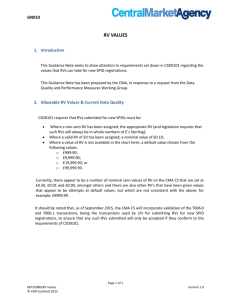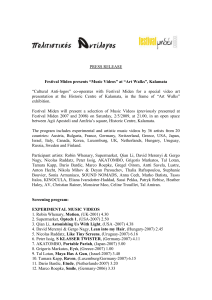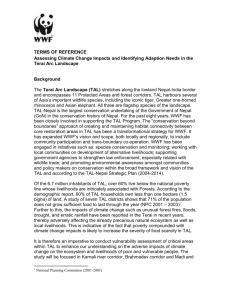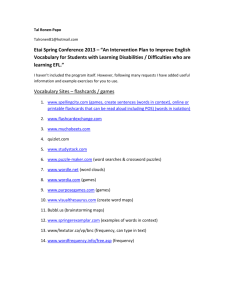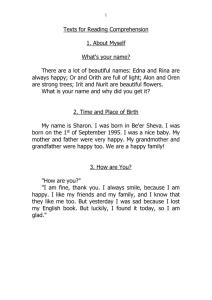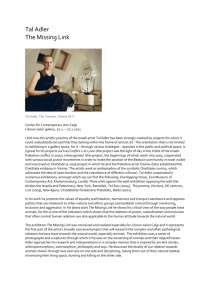pro2873-sup-0001-suppinfo01
advertisement
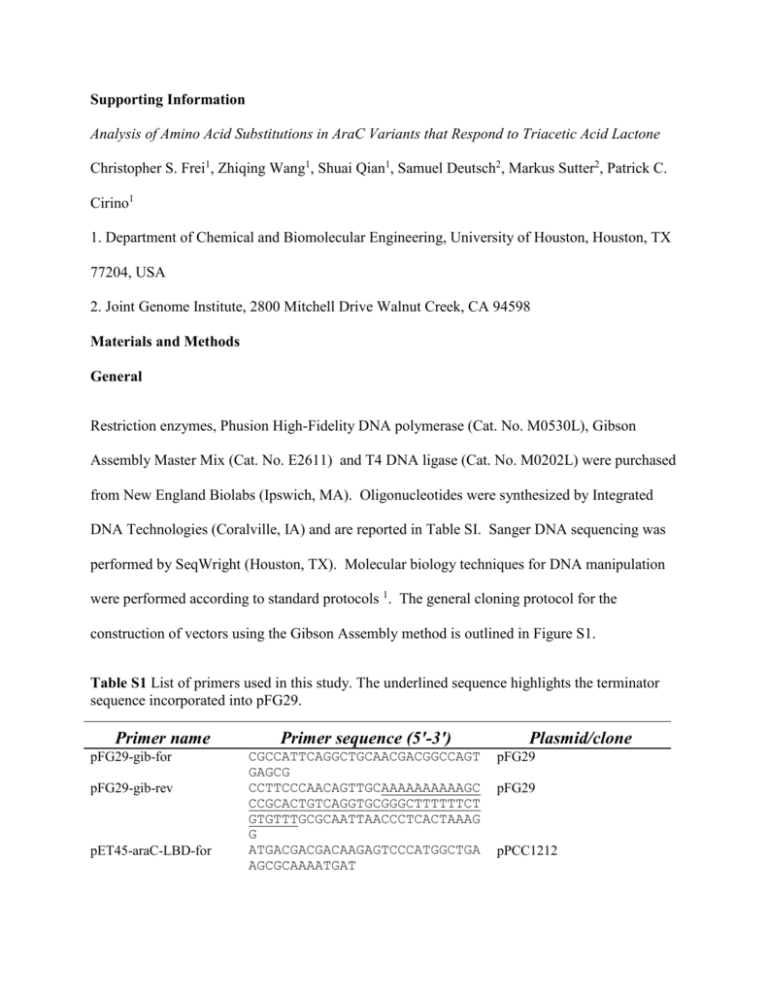
Supporting Information Analysis of Amino Acid Substitutions in AraC Variants that Respond to Triacetic Acid Lactone Christopher S. Frei1, Zhiqing Wang1, Shuai Qian1, Samuel Deutsch2, Markus Sutter2, Patrick C. Cirino1 1. Department of Chemical and Biomolecular Engineering, University of Houston, Houston, TX 77204, USA 2. Joint Genome Institute, 2800 Mitchell Drive Walnut Creek, CA 94598 Materials and Methods General Restriction enzymes, Phusion High-Fidelity DNA polymerase (Cat. No. M0530L), Gibson Assembly Master Mix (Cat. No. E2611) and T4 DNA ligase (Cat. No. M0202L) were purchased from New England Biolabs (Ipswich, MA). Oligonucleotides were synthesized by Integrated DNA Technologies (Coralville, IA) and are reported in Table SI. Sanger DNA sequencing was performed by SeqWright (Houston, TX). Molecular biology techniques for DNA manipulation were performed according to standard protocols 1. The general cloning protocol for the construction of vectors using the Gibson Assembly method is outlined in Figure S1. Table S1 List of primers used in this study. The underlined sequence highlights the terminator sequence incorporated into pFG29. Primer name pFG29-gib-for pFG29-gib-rev pET45-araC-LBD-for Primer sequence (5'-3') CGCCATTCAGGCTGCAACGACGGCCAGT GAGCG CCTTCCCAACAGTTGCAAAAAAAAAAGC CCGCACTGTCAGGTGCGGGCTTTTTTCT GTGTTTGCGCAATTAACCCTCACTAAAG G ATGACGACGACAAGAGTCCCATGGCTGA AGCGCAAAATGAT Plasmid/clone pFG29 pFG29 pPCC1212 pET45-araC-LBD-rev AGCTCCCAATTGGGATACCCTCACGACT CGTTAATCGCTTCCATG pPCC1212 pFG29_araC_GS_fwd_1 ATAAGAGACACCGGCATACT All MutXXXXX mutants, recloned araC-TAL mutants pCC1305_araCTAL_rvs ATGCGTTGGTCCTCGCGC All MutXXXXX mutants, recloned araC-TAL mutants 00001_1_WT_rvs 00001_2_TAL_fwd 10000_1_WT_rvs 10000_2_WT_fwd 00010_1_WT_rvs 00010_2_WT_fwd 00001 00001 10000 10000 00010 00010 00111_1_WT_rvs ATACCATTCGCGAGCCTC GAGGCTCGCGAATGGTAT TACTCGTTTAACGCCCAT GCCACCAGATGGGCGTTA CAAGTGATGAATCTCTCCTGGC GCCAGGAGAGATTCATCACTTGGGTCGT CATCC GCCAATCTCTCCTGGCGGGAACAGCA TGCTGTTCCCGCCAGGAGAGATTGGCCA CTTGG ATCTCTCCTGGCGGGAACAG 00111_2_TAL_fwd 01000_1_WT_rvs 01000_2_TAL_fwd 01000_3_WT_fwd 01000_2_TAL_rvs 01011_1_WT_rvs CTGTTCCCGCCAGGAGAGAT TTAAACCCGCCACCAGATG CCATCTGGTGGCGGGTTTAA GCTGTTCCCGCCAGGAGAGATT AATCTCTCCTGGCGGGAACAGC CCACCAGATGGGCGTTAAAC 00111 01000 01000 01000 01000 01011, 01100, 01101, 10001, 01110, 10001, 10010, 10011, 10100, 10101, 01001, 01010, 10110 01011_2_TAL_fwd GTTTAACGCCCATCTGGTGG 01011, 01100, 01101, 10001, 01110, 10001, 10010, 10011, 10100, 10101, 01001, 01010, 10110 01011_3_TAL_fwd CTGTTCCCGCCAGGAGAGATTCATCACT TGGG CTGTTCCCGCCAGGAGAGATTGGCCACT ACGGT GCCAATCTCTCCTGGCGGGAACAG GCCAGGAGAGATTGGCCACTACGGTCGT CAT GTAGTGGCCAATCTCTCCTGGC CGGAGGCTCGCGAATGGTAT ATACCATTCGCGAGCCTCCG TAAACCCGCCACCAGATGGGC GCCCATCTGGTGGCGGGTTTA CGGAGGCTCGCGAATGGTAT 01011 00100_1_WT_rvs 00100_2_WT_fwd 01100_3_WT_fwd 01100_2_TAL_rvs 01101_3_TAL_fwd 01101_2_TAL_rvs 10001_3_TAL_fwd 10001_2_WT_rvs 01111_1_WT_rvs 01111_2_TAL_fwd 10001_3_TAL_fwd 00100, 11100 00100, 11100 00111, 01011, 10100, 01001, 01010, 10110, 11001, 11010 01100 01100 01101 01101 10001, 01110 10001, 01110 01111 01111 10001 10001_2_WT_rvs 10010_3_WT_fwd 10010_2_WT_rvs 10011_3_TAL_fwd 10011_2_WT_rvs 10100_3_WT_fwd 10101_3_TAL_fwd 10101_2_WT_rvs 10111_1_TAL_rvs 10111_2_WT_fwd 10111_3_TAL_fwd 10111_2_WT_rvs 11011_1_TAL_rvs 11011_2_TAL_fwd 11101_1_TAL_rvs 11101_2_TAL_fwd 11110_1_TAL_rvs 11110_2_WT_fwd 00101_1_WT_rvs 00101_2_TAL_fwd 00110_1_WT_rvs 00110_2_WT_fwd 01001_3_TAL_fwd 01010_3_WT_fwd 11010_2_WT_fwd Adding_ScaI_Fragment_ 1_fwd araCTAL_5_AvrII_rvs AraCTAL_5 pCC1305_araCTAL_rvs pCC1321_PciI_PBAD pCC1321_AgeI_PBAD ATACCATTCGCGAGCCTCCG CCGCCAGGAGAGATTCATCACTTGGGTC GTCA TGATGAATCTCTCCTGGCGG GCCAGGAGAGATTCATCACTTGGGTCGT CA AGTGATGAATCTCTCCTGGC CTGTTCCCGCCAGGAGAGATTGGCCACT ACGGT TCCCGCCAGGAGAGATTGGCCACTACGG TCGTCAT GCCAATCTCTCCTGGCGGGAACA TTAAACCCGCCACCAGATG CCATCTGGTGGCGGGTTTAA GCTGTTCCCGCCAGGAGAGATT AATCTCTCCTGGCGGGAACAGC ATGAATCTCTCCTGGCGGGAACAGCA TGCTGTTCCCGCCAGGAGAGATTCATCA CTTGGGTC GTAGTGGCCAATCTCTCCTGGC GCCAGGAGAGATTGGCCACTACGGTCGT CATCC ATACCATTCGCGAGCCTC GAGGCTCGCGAATGGTAT GCCAATCTCTCCTGGCGGGAAC CCCGCCAGGAGAGATTGGCCACTACGGT CGTCA CAAGTGGCCAATCTCTCCTGGCGGGAAC A TGTTCCCGCCAGGAGAGATTGGCCACTT GGGTCGTCA CTGTTCCCGCCAGGAGAGATTCATCACT ACGGTCGTCA CTGTTCCCGCCAGGAGAGATTCATCACT TGGGTCGTCA CTGTTCCCGCCAGGAGAGATTCATCACT TGGGTCGTCA CCCCAGCAGGCGAAAATCCTGTTTG 10001 10010 ATTTTGCGCTTCAGCCATCCTAGGTATC TCCTGTG ATGGCTGAAGCGCAAAATGATCC ATGCGTTGGTCCTCGCGC TTTTGCTGGCCTTTTGCTCAACTTTTCA TACTCCCGCC GCTTTTAATAAGCGGGGTTA pPCC1321 10010 10011, 00011 10011, 00011 10100 10101 10101 10111 10111 10111 10111 11011 11011 11101 11101 11110 11110 00101 00101 00110 00110, 10110 01001, 11001 01010 11010 pPCC1321 pPCC1321 pPCC1321 pPCC1322 pPCC1322 Figure S1 General protocol for Gibson Assembly Integration of a PBAD-bla reporter construct into HF19 for ampicillin selection. Strain SQ12 was created by integrating a fragment of DNA containing PBAD-bla (conferring ampicillin resistance regulated by the AraC cognate promoter PBAD) into the genome of strain HF19 using the “CRIM” method 2. The PBAD-gfpuv was amplified from plasmid pFG29 using primers pPCC1215-gib-for and pPCC1215-gib-rev, and then inserted into NcoI-digested CRIM plasmid pPCC20 3 by Gibson Assembly, resulting in plasmid pPCC1215. The bla gene was amplified from pET45b using primers pPCC1217-gib-for and pPCC1217-fib-rev and cloned into pPCC1215 digested with NdeI and SpeI using Gibson Assembly, resulting in plasmid pPCC1217. Plasmid pPCC1217 was subsequently integrated into the chromosome of HF19 at the HK022 site resulting in SQ11. Apramycin resistant colonies were selected and the integration was verified by PCR. Removal of FRT-flanked apramycin resistance cassette was achieved as described 4, resulting in strain SQ12. Cloning of plasmids for screening and AraC library. Construction and expression of the mutant library was carried out as previously described 5. Initial work was based on the dual plasmid reporter system for AraC-controlled GFPuv expression as described previously 5, in which AraC and the AraC combinatorial library (SLib4) are expressed from plasmid pPCC423 (maintained by apramycin antibiotic resistance) under control of IPTG-inducible LacI. In this system, PBADcontrolled GFPuv expression occurs on a second plasmid, pPCC442 (maintained by chloramphenicol resistance). Plasmid pPCC423 was subsequently modified to pPFG1 (described below) and the dual plasmid system was converted to a single plasmid pFG29 as described below. The PBAD-gfpuv reporter was cloned into plasmid pFG1 (yielding pFG29) using the Gibson Assembly method. Primers pFG29-gib-for and pFG29-gib-rev were designed to amplify PBADgfpuv from pPCC442. Primer pFG29-gib-rev incorporated a terminator sequence (AAAAAAAAAAGCCCGCACTGTCAGGTGCGGGCTTTTTTCTGTGTTT). PBAD-gfpuv was amplified using Phusion polymerase. The resulting PCR product was gel purified. The pFG1 vector was cleaved with the FspI restriction enzyme. These fragments were mixed and assembled according to the Gibson Assembly protocol. The resulting plasmid was named pFG29, containing Ptac-araC and PBAD-gfpuv. All AraC-TAL mutants of interest were cloned into plasmid pFG29 (from their pPCC423 source vector) for analysis following isolation from the SLib4 library. This was done by PCR amplification of araC variants using primers pFG29-araC-GS and pPCC1305_araCTAL-rvs. The products and pFG29 vector were subjected to sequential digest by AflII and BstapI. The purified products were ligated using T4 DNA ligase and transformed into electroporation competent MC1061 cells. Sequencing of the final clones confirmed the correct sequences. AraC-TAL Variants Characterization and Analyses Dose-dependent responses of AraC-TAL variants. To better characterize the newly isolated AraC-TAL variants, we determined the dose-dependent response of each variant to TAL (1-25 mM) using the protocol outlined in the Materials and Methods section. Each variant shows a dose-dependent response to TAL (Figure S2). However due to the toxicity of high concentrations of TAL (>25 mM), the full dynamic range of response could not be determined for most variants. Figure S2 TAL-dependent dose response of AraC-TAL variants. Data is reported as the average and standard deviation of three independent experiments in relative fluorescence units (A) and fold-response (B). The fold-response was calculated by dividing the bulk fluorescence in the presence of TAL by the bulk background fluorescence in the absence of TAL. AraC-TAL fold-response depends on residue hydrophobicity and charge. The hydrophobicity of each amino acid substitution was determined from residue sidechain hydrophobicity values provided Kyte and coworkers 7. Plotting the total change in hydrophobicity for each variant versus the respective response of the variant shows a positive correlation between an increase in amino acid substitution hydrophobicity and response (Figure S2). The change in hydropathy (ΔHydropathy) of the ligand binding domain (LBD) was calculated by summing the corresponding hydropathy values for the substituted residues of each variant and subtracting the wt-AraC value (Table S2). In addition to the hydropathy, the net charge was also calculated. In all variants, the net charge was positive (at a neutral pH), but the variants with the greatest charge were the least responsive. Figure S3 Scatter plot representing the trend of hydrophobicity from amino acid substitutions and fold-response to 5 mM TAL. The hydrophobicity data was calculated from the hydrophobicity indices calculated by Kyte and coworkers. The red line in the scatter plot represents the simple linear regression model fitted to the respective data. There is a positive correlation showing that the fold-response to 5 mM TAL increases as the hydrophobicity increases. Table S2 Charge and hydrophobicity of amino acid substitutions in the AraC-TAL clones. (A) Net change in charge (Δz) of the LBD shows there is a net positive charge for all AraC-TAL variants. The net change in hydrophobicity was calculated according to (B) Kyte and coworkers. Each AraC-TAL variant showed positive net charge and a positive net hydropathy (more hydrophobic) in the LBD. A Clone WT-AraC AraC-TAL1 AraC-TAL2 AraC-TAL3 AraC-TAL4 AraC-TAL5 AraC-TAL6 AraC-TAL7 AraC-TAL8 AraC-TAL9 AraC-TAL10 8 P V G S S I G V G T G Residue 24 80 82 93 T H Y H I G L R H H K L I G I R L G L R L G I R L H K V L G L R L H K F I G L R L G I R 8 0 0 0 0 0 0 0 0 0 0 0 Residue B 24 0 0 0.09 0 0 0 0 0 0 0 0 80 0.09 0 0.09 0 0 0 0.09 0 0.09 0 0 z (pH 7) 82 93 0 0.09 0 1 1 0 0 1 0 1 0 1 1 0 0 1 1 0 0 1 0 1 zsum 0.18 1 1.18 1 1 1 1.09 1 1.09 1 1 Δz 0.00 0.82 1.00 0.82 0.82 0.82 0.91 0.82 0.91 0.82 0.82 Hydropathy (Kyte et al. 1982) Clone WT-AraC 8 P 24 80 82 93 T H Y H 8 -1.6 24 -0.7 80 82 -3.2 -1.3 93 -3.2 HI -10.0 ΔHI - AraC-TAL1 AraC-TAL2 AraC-TAL3 AraC-TAL4 AraC-TAL5 AraC-TAL6 AraC-TAL7 AraC-TAL8 AraC-TAL9 V G S S I G V G T I H I L L L L L I G H G G G H G H G L K I L I K L K L R L R R R V R F R 4.2 -0.4 -0.8 -0.8 4.5 -0.4 4.2 -0.4 -0.7 4.5 -3.2 4.5 3.8 3.8 3.8 3.8 3.8 4.5 -0.4 3.8 -3.2 -3.9 -0.4 4.5 -0.4 3.8 -0.4 4.5 -3.2 -3.9 -0.4 3.8 -3.2 -3.9 -0.4 3.8 -4.5 3.8 -4.5 -4.5 -4.5 4.2 -4.5 2.8 -4.5 7.6 -6.9 3.3 1.9 7.9 0.5 6.9 -0.9 2.7 17.6 3.1 13.3 11.9 17.9 10.5 16.9 9.1 12.7 AraC-TAL10 G L G I R -0.4 3.8 -0.4 -4.5 3.0 13.0 4.5 AraC-TAL variants show specificity towards TAL. The specificity of the AraC-TAL variants was tested in the presence of two compounds similar to TAL, phloroglucinol and 2,6-dimethyl-γpyrone. The dose response was setup as described in the Materials and Methods. Phloroglucinol and 2,6-dimethyl-γ-pyrone were prepared fresh and dissolved directly in the media to 50 mM. Error bars were incorporated and represent the standard deviation of four replicate cultures. Dilutions were made from this stock solution. None of the variants show a high response to either compound. AraC-TAL6 shows a slight response to phloroglucinol at low concentrations. Figure S4 Dose dependent responses of AraC-TAL variants to (A) phloroglucinol and (B) 2,6dimethyl-γ-pyrone. L-Arabinose is Not an Inhibitor of TAL Response The response of AraC-TAL1 in the presence of L-ara was investigated to determine the extent of L-ara binding. The competition assay was setup following the protocol for deep-well plate dose responses described in the Materials and Methods section. HF19 cells harboring either pFG29 or pFG29-TAL1 were screened for response to TAL (0.5 – 25 mM) in the presence and absence of 1 mM L-ara in the media. Also, the response of AraC-TAL1 to 5 mM TAL in the presence of varying concentrations of L-ara (0.001-10 mM L-ara) was determined. As can be seen in Figure S5, the response of AraC-TAL1 was not affected by the presence of L-ara. Figure S5 Competition assay to determine the effect of the presence of L-ara on AraC-TAL1 response to TAL. AraC-TAL LBD Purification Protein gel analysis of soluble LBD of AraC-TAL clones. Due to the low solubility of the AraC-TAL1 LBD, we examined the remaining AraC-TAL variants to test whether any were more soluble than AraC-TAL1. AraC-TAL variants were cloned into the pET45b vector and expressed as described in the Materials and Methods section of this manuscript. The induced cells were lysed by boiling in lysis buffer for 10 min. The soluble fraction of the lysed cells was loaded onto a SDS-PAGE gel. Based on analysis of SDS-PAGE gel band intensities, no variants appeared more soluble than AraC-TAL1. Supplementary Information References 1. 2. 3. 4. 5. 6. 7. Sambrook J, Russell DW. Molecular cloning: a laboratory manual. Cold Spring Harbor, N.Y: Cold Spring Harbor Laboratory Press; 2001. Haldimann A, Wanner BL. Conditional-replication, integration, excision, and retrieval plasmid-host systems for gene structure-function studies of bacteria. Journal of Bacteriology [H.W.Wilson - GS] 2001;183(21):6384. Chin JW, Khankal R, Monroe CA, Maranas CD, Cirino PC. Analysis of NADPH supply during xylitol production by engineered Escherichia coli. Biotechnol Bioeng 2009;102(1):209-20. Causey TB, Zhou S, Shanmugam KT, Ingram LO. Engineering the metabolism of Escherichia coli W3110 for the conversion of sugar to redox-neutral and oxidized products: Homoacetate production. Proceedings of the National Academy of Sciences of the United States of America 2003;100(3):825-832. Tang S-Y, Fazelinia H, Cirino PC. AraC regulatory protein mutants with altered effector specificity. J Am Chem Soc 2008;130(15):5267-71. Tang S-Y, Qian S, Akinterinwa O, Frei CS, Gredell JA, Cirino PC. Screening for enhanced triacetic acid lactone production by recombinant Escherichia coli expressing a designed triacetic acid lactone reporter. Journal of the American Chemical Society 2013;135(27):10099-10103. Kyte J, Doolittle RF. A simple method for displaying the hydropathic character of a protein. Journal of Molecular Biology 1982;157(1):105-132.

